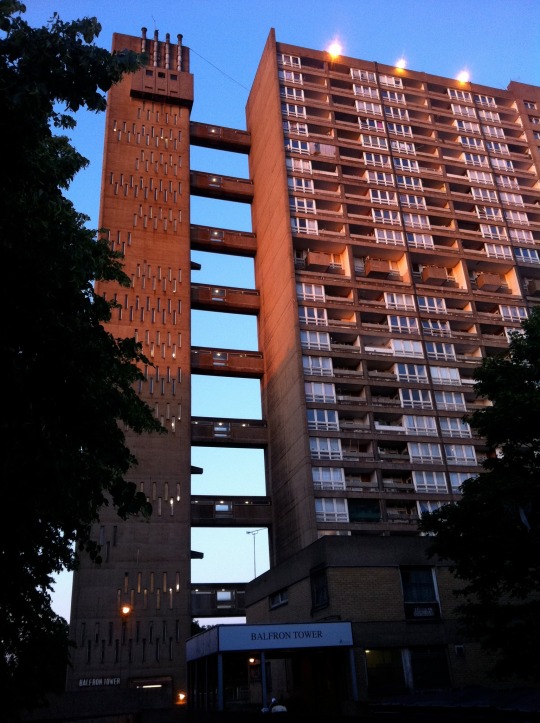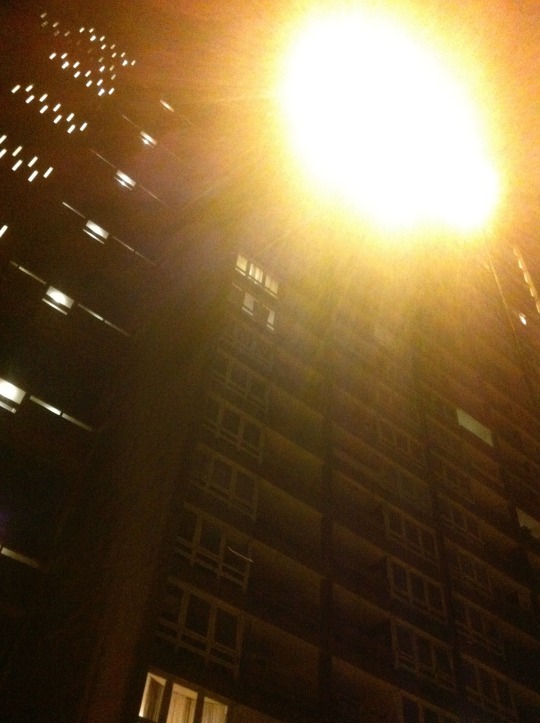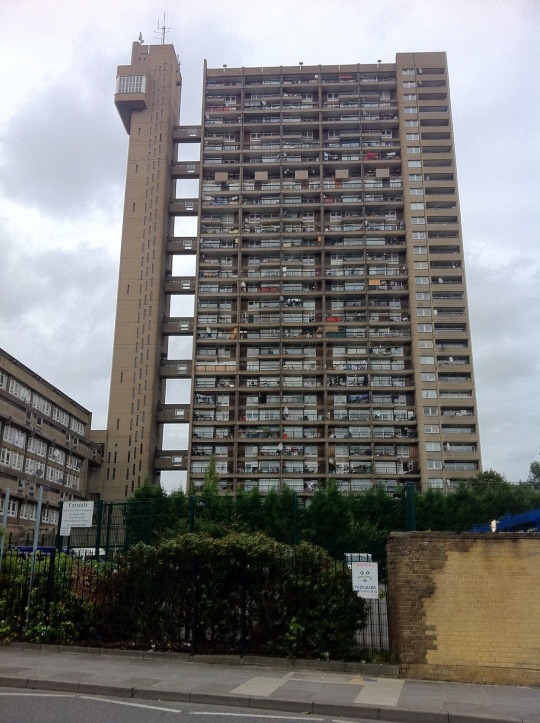
Balfron Tower in 2011 pic: @BalfronSocial
I am not so idealistic as to think there was no conflict in a mixed
demographic, but a society will always find conflict regardless of
the social strata. For the statutory services it seems that in times
of greater austerity, then the goal is to reduce cost to one’s own
organisation and to profit regardless of the human lives fragmented
in the midst of the business transactions. There seems to be
ignorance of the reality that for us all to function we need the
complex mix of people, who provide all the services, the support to
their community, friends and families and that wholesale export of
those with low income will destroy that delicate balance.
The London I loved as a teenager was one of diversity, a city where
rich and poor lived in close proximity with cross-fertilisation of
cultures and ideas. My grandfather lived in Ilford and we would drive
to East London from Kingston-Upon-Thames in the late 1970s, passing
Blooms Restaurant in Whitechapel, to visit him on Sundays. Before
retirement he used to work at Truman’s brewery in Brick Lane making
copper pots. I’m sure that the drive through London cemented my love of the East London. I also wonder whether my father’s working-class start
grounded me with a sense of gratitude for my own privilege and a
respect for others who are down on their luck or living happily on a
lower income. This has never left me and despite now realising I am
part of the problem, as a property owner, I also feel the need to
speak out for those who are being treated as if their connections and
lives were transitory and insignificant. There has always been social
cleansing and gentrification, but if feels now as though we should
know better and not allow councils that want to remove ‘these
people’, who may cost more in terms of support needs than the
wealthy new tenants of privatised developments.

The view from Balfron Tower. pic: @BalfronSocial
I bought my Balfron Tower flat in 2001; I love tower blocks, the
solid build of old council flats, the Goldfinger ethos and
architecture, the history and the area and I wanted an investment
property to rent out. In 2010 I received a letter re: a meeting for
tenants and leaseholders regarding the refurbishment of the block.
From the meeting the original provisional cost proposed was £120k
for my flat alone: this is always a risk as a leaseholder, but
perhaps rare to incur such an extreme cost. In October 2011 I wrote
for an update, in the absence of communication from Poplar Harca, and
was told that the start date for works may be at the end of 2012 or
the start of 2013. There was uncertainty for the tenants, with no
definitive decision as to whether they would be able to return, nor
an explanation as to what was causing the delay in decision making.
Transparency would have been appreciated. I was
asked to move my tenants out in December 2013, when I checked whether
their tenancy could be renewed. I believe I am one of around 10
leaseholders and am awaiting a notice re: the detailed works, the
date of which keeps slipping and is now around September 2015.
There has been very poor communication (despite
a named person for a very small number of leaseholders), shifting
deadlines and money wasted in leaving the block empty. The money
needs to be made somehow for a Grade II listed concrete tower block
to be refurbished, but I question why there has not been ongoing
maintenance given the very high service charges (nearly £4000 per
year for a 4-bedroom flat)? However, given the <10% leaseholders,
perhaps this service charge has only been realised for <10% of the
flats. Also given the heritage interest I wonder how much grant money
/ philanthropic investment options have been explored, in order to keep the
properties predominantly as social housing. If the situation is that
only Balfron’s sale will make enough money to provide many more
low-rent homes, then there needs to be transparency through a
financial breakdown available to all. I am not convinced the
wholesale loss of social housing is for altruistic means, nor that
there will be the local good quality low rent properties available to
those being moved out. The communication I have received has been
incredibly vague and intermittent. As a tenant the stress of the
unknown and whether to leave or hold out must have been pretty
unbearable and potentially led to some forced decision making.

The View from Balfron Tower pic: @BalfronSocial
I
also feel that some housing organisations do not maintain their
housing well, sometimes pay obscene rents to private landlords way
above an acceptable level and do not manage empty properties. My
(perhaps naïve) view is that there should be rent caps for landlords
and there needs to be improved legislation re: taking back empty
properties and refurbishing them at a reasonable cost. I support
private housing supporting the costs in a mixed property with a
shared entrance; I do not support forced eviction of individuals and
families. I would support assessing the desires of all residents /
owners when such a project is proposed, but not in a tokenistic way
if this is not going to affect the outcome. If I have had
difficulties getting appropriate responses and adequate property
maintenance from Poplar Harca, I fear that tenants will have had a
much poorer response. The mail had piled up, despite an agreement
that Poplar Harca were to manage the post. There was also a late rent
payment to me, with little concern for the fact: would this have been
their response if a tenant had been late in paying their rent? This
is not a great role model for an organisation that is quick to
challenge tenants for their behaviour.
I was not happy to hand over the keys to Poplar Harca without some
form of contract, which took quite some chasing up to achieve despite
the transfer of tenancy having happened. Poplar Harca took on the
flat 12th January 2014 and have been paying the rent
(value as confirmed by the estate agents) ever since; the rent for a
four double bedroom flat on two floors was £1500 per month. In
December 2013 I was given the following information re: the potential
cost to me as a leaseholder: ‘looking at an average cost slightly
above the £70k mark’. In September 2014 I received a letter from
Poplar Harca with cost to owners possibly from £105-135k. This is
the time when it became known to me that there would be no social
housing in the block.

Has the sun set on mixed community in Balfron Tower? pic: @BalfronSocial
As much as I am an advocate of the arts, even as a leaseholder
hearing via social media of various arts projects in the block and of the use of ‘property guardians’ was galling: perhaps a personal invitation may
have showed some recognition of the lives in the block. There is a
story to be told by the block, but I think these art projects
backfired, as it brought attention to the story of the attempted
gentrification and failure to honour the history and residents of the
block. Residents whose lives were in that block have been dismissed
despite no work occurring. I reflect on what role the ‘property
guardians’ are fulfilling (although fully understand why a person
would be one) and why Poplar Harca is paying me rent for well over a
year when I could have been saving them money and getting that rent
from tenants? I just wish that Occupy, Focus
E15, Our West Hendon, the New Era group, Tower Hamlets Renters,
Action East End and the other excellent collective housing saviours
had been there in 2010, so that a campaign could have started whilst
tenants were resident. The insidious creep to total privatisation
over more than 4 years has precluded this.
I would like to thank Balfron Social Club
(twitter.com/BalfronSocial)
for inviting me to write this article. Their hard work, passion and
unending knowledge of and dedication to challenging poor practice and
raising awareness of the injustice of social cleansing has been
inspiring. They have supported and guided me in making key links with
other excellent people, who will not stand by and see the most
vulnerable people in our community be treated so badly. It is only by
our collective action that change will happen.

Trellick Tower in West London. A mixed tenure block that Balfron Tower should aspire to emulate? pic: @BalfronSocial
I am currently working in the shadow of the equally glorious Trellick
Tower in West London, more famous and more coveted than Balfron over
the years, yet still maintaining mixed residency. I think it is still
not too late to challenge the plans for Balfron, as the Section 20
agreement has not been issued. Balfron is a landmark for low cost
housing and could be an amazing model for mixed private and social
housing, with a community that supports each other with skills and
ideas. Or it could become the vision described in J.G. Ballard’s
‘High-Rise’ where the rich create their own ‘Lord of the Flies’
in their battle over the status of floor level in 21st
century tower block envy.
Dr. Vanessa Crawford
for Balfron Social Club
Poplar
23 June 2015

